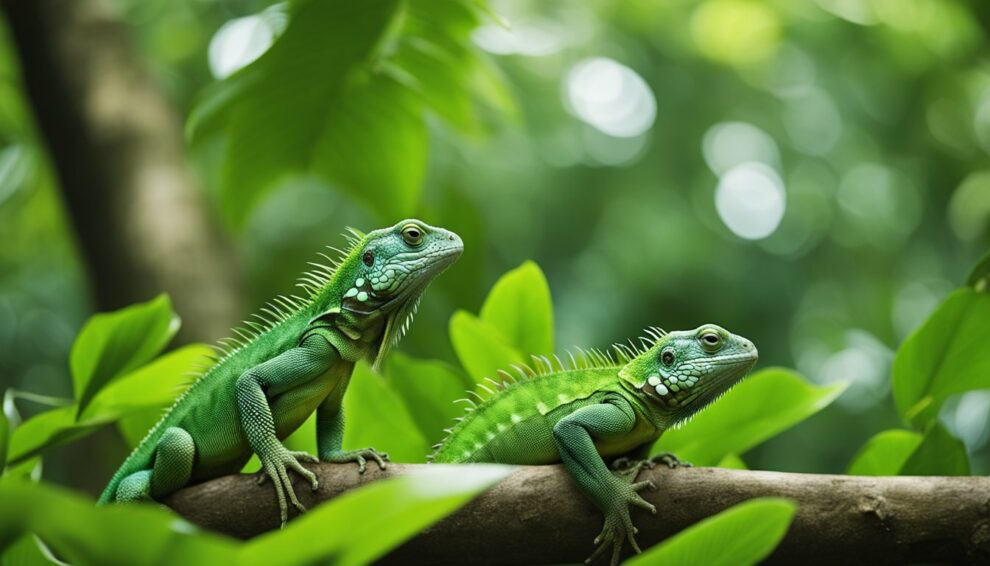Fiji banded iguanas are masters of movement among the treetops of the South Pacific islands.
With their vibrant green and blue stripes that seem to paint the very essence of the tropical forests they inhabit, these iguanas spend most of their lives in the canopies.
Agile and adept, they navigate the complex network of branches with ease.
But have you ever wondered how these reptiles perform such impressive feats of acrobatics high above the ground?

Their secret lies in their remarkable adaptations. The long, slender bodies of Fiji banded iguanas are perfectly designed for an arboreal lifestyle.
Their sharp claws grip onto bark like Velcro, and their tails, which can be as long as their bodies, provide balance and aid in steering as they leap from branch to branch.
Can you picture the grace of a gymnast as you think of an iguana gliding through the air?
Even with their startling speed and agility, Fiji banded iguanas also understand the art of stillness.
They can remain motionless for hours, blending seamlessly with their leafy surroundings to hide from predators.
Their ability to stay undetected is their superpower in the wild.
It’s not just their movements that are captivating, but their stillness too can be just as mesmerizing.
Isn’t it astonishing how these creatures have perfectly adapted to life among the leaves?
Fiji Banded Iguana Basics
Imagine walking through the lush rainforests of Fiji and spotting a bright green lizard with vivid blue bands!
That’s the Fiji banded iguana, a sight to behold.
These iguanas are not just a splash of color in the forest; they have unique features and live in fascinating places.
Physical Characteristics
When you first lay eyes on a Fiji banded iguana, you’ll be struck by its vibrant colors.
Males typically boast a brilliant green body with dynamic blue stripes, while females tend to have a more subdued green appearance.
Don’t be fooled by their bright exterior; these colors serve a purpose, helping them blend into their leafy habitats.
When it comes to size, an adult iguana can grow up to 60 centimeters in length. Each has strong limbs and sharp claws, perfect for a life spent among the trees.
Those claws aren’t just for climbing; they help Fiji banded iguanas leap from branch to branch with the greatest of ease.
Habitat and Distribution
Have you ever wondered where these acrobatic reptiles call home?
Fiji banded iguanas are found, unsurprisingly, in the Fiji islands as well as the Tonga archipelago.
They favor tropical forests, thriving in both lowland and mountainous areas, up to elevations of 600 meters.
The iguanas are arboreal, which means they love spending most of their time in the trees.
It’s not just any tree that will do; they show a penchant for living in areas with dense foliage and plenty of sunlight to bask in.
Sadly, their homes are at risk, and these iguanas are vulnerable due to habitat loss and invasive species.
So next time you’re reading about tropical forests or planning a trip to Fiji or Tonga, think about the tree-dwelling Fiji banded iguanas, whose survival hangs in the delicate balance of their environment.
Aerial Agility

The Fiji Banded Iguanas are truly impressive when it comes to moving through the treetops.
These nimble reptiles have remarkable skills that allow them to flourish high above the ground.
Tree Navigation
Fiji Banded Iguanas are masters of their leafy domain.
They spend a significant portion of their lives in trees, which has led to the development of unique adaptations for arboreal travel.
These iguanas possess long, slender bodies and tails, and use their sharp claws to grip and clamber from branch to branch with ease.
Can you imagine the balance it takes to walk on a swaying twig?
Their muscular limbs can also propel them upwards, helping them scale vertical challenges or reach for the next handhold.
While traversing their canopies, iguanas will confidently leap when needed, using their tail to steer mid-air.
It’s like they have their own built-in tightrope walking skills!
Predator Evasion
Escaping predators is part of daily life when you’re as eye-catching as the Fiji Banded Iguana.
When danger looms close, their agility shines through as they make quick, darting movements through the branches.
It’s not just about speed, but also clever moves. They can change direction in an instant or even drop into thick foliage to disappear from view.
Did you know these nimble creatures can also freeze in place, blending into the leaves with their green-striped camouflage?
This natural trickery confuses predators just long enough for the iguanas to make a speedy getaway.
Being able to move like a gust of wind and hide like a chameleon gives them the ultimate game plan for safety amongst the treetops.
They aren’t just survivors; they’re escape artists with a flair for the dramatic.
Diet and Foraging Behavior

The Fiji banded iguanas are skilled foragers, primarily herbivorous, they demonstrate a preference for certain foods and employ unique techniques to gather their meals.
Foods of Choice
These vibrant green reptiles have a diet consisting mainly of leaves, flowers, and fruits, which they find in their treetop habitats.
They are particularly fond of the hibiscus and its blossoms, as well as the fruit of the pandanus tree.
When eating leaves, Fiji banded iguanas tend to select young, tender shoots over tougher, mature foliage.
Their choices often contain more nutrients and are easier to digest.
Foraging Techniques
Curiously peeking into the lives of these iguanas reveals their methodical approach to foraging.
They move with deliberate care, navigating the complex canopy with a grace that seems almost like a dance.
Using their long, slender toes, they deftly grasp branches while reaching for food, often stretching their lithe bodies to incredible lengths to pluck a distant treat.
Such a spectacle leaves one wondering, do they think it’s a game, stretching and reaching for that best bite?
Frequently Asked Questions

Curious about the incredible tree-dwelling escapades of the Fiji banded iguanas?
This section covers their remarkable abilities and interesting lifestyle.
How do Fiji banded iguanas perform their treetop acrobatics?
Fiji banded iguanas are true specialists when it comes to navigating the treetops. Their strong limbs and grippy toes help them cling to branches with ease.
Grasping tightly, they leap and climb with astonishing agility, which enables them to evade predators and seek out food high up in the canopy.
What makes Fiji banded iguanas stand out in their natural habitat?
In the lush forests of Fiji, these iguanas are a dazzling spectacle. Their vibrant green and blue bands provide excellent camouflage among the foliage.
This coloration not only helps them blend in but also serves as a communication tool during social interactions.
Can you own a Fiji banded iguana, and what are the legal considerations?
Fiji banded iguanas are not common pets, mainly due to strict regulations. They are protected species, and international trade is heavily controlled.
Any potential owners must comply with local and international laws, including the Convention on International Trade in Endangered Species (CITES).
What do Fiji banded iguanas typically eat in their natural environment?
These agile lizards are herbivores, feeding on a diet mostly made up of leaves, flowers, and fruit.
Their feeding habits play a crucial role in seed dispersal, making them important contributors to the health of their tropical ecosystem.
What’s fascinating and unique about the history of Fiji banded iguanas?
The history of Fiji banded iguanas is tied to the islands they inhabit.
They are believed to have arrived in Fiji millions of years ago, and their isolation led to unique adaptations.
Studies of these iguanas can provide insights into the processes of evolution and island biogeography.
How are conservationists working to increase the population of Fiji banded iguanas in the wild?
Conservationists employ a mix of habitat protection, research, and breeding programs.
By safeguarding forests and reducing threats such as invasive species, they help to create a safer environment for these iguanas.
Captive breeding programs also aim to bolster wild populations and ensure the species’ survival for future generations.









